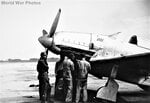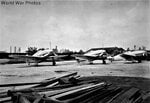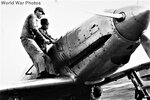Navigation
Install the app
How to install the app on iOS
Follow along with the video below to see how to install our site as a web app on your home screen.
Note: This feature may not be available in some browsers.
More options
You are using an out of date browser. It may not display this or other websites correctly.
You should upgrade or use an alternative browser.
You should upgrade or use an alternative browser.
eBay: Kawasaki Ki-61 Hien / Tony captured
- Thread starter Snautzer01
- Start date
-
- Tags
- 275154275155 captured hien ki-61 tony
Ad: This forum contains affiliate links to products on Amazon and eBay. More information in Terms and rules
More options
Who Replied?johnbr
2nd Lieutenant
johnbr
2nd Lieutenant
Ki-60
Specifications (Ki-60)
Data from Warplanes of the Second World War, Volume Three: Fighters; WW2 Aircraft Fact Files: Japanese Army Fighters, Part 1; Japanese Aircraft of the Pacific War.
General characteristics
Crew: One
Length: 8.40 m (27 ft 9.5 in)
Wingspan: 9.78 m (34 ft 5.5 in)
Height: 2.75 m (9 ft 10 in)
Wing area: 16.20 m² (15.9 m² first prototype) (174.376 ft² (171.15 ft²)).
Empty weight: 2,150 kg (4,740 lb)
Loaded weight: 2,750 kg (2,890 kg first prototype) (6,063 lb (6,371 lb)).
Power plant: 1 × Daimler-Benz DB 601 liquid-cooled inverted V-12, 875 kW (1,175 hp)
Performance
Maximum speed: 560 km/h (348 mph) at 4,500 meters (14,800 ft).
Service ceiling: 10,000 m (32,810 ft).
Wing loading: 169.8 kg/m² (34.8 lb/ft²).
Power/mass: 3.14 kg/kW (2.34 kg/hp; 5.16 lb/hp).
Time to altitude: 8.0 min to 5,000 meters (16,000 ft) for the 1st
prototype; 6.0 min to 5,000 meters (16,000 ft) for the 2nd and 3rd prototypes.
Armament
2 x 20 mm Mauser MG 151 cannon or 2 x 12.7 mm (0.50 in) Ho-103 machine guns in the wings.
2 x 12.7 mm (0.50 in) Ho-103 synchronized machine guns in the fuselage.
From the start of flight testing it became apparent that the design was seriously flawed in several key areas. The take-off run was unacceptably long, while in flight the aircraft displayed some lateral instability, excessively heavy controls and poor control response. The spinning characteristics were described as "dangerous" and the stalling speed was extremely high. Although a top speed of 600 kilometers per hour (370 mph) had been projected the Ki-60 was only able to achieve 548 kilometers per hour (341 mph).
As a result, the second and third prototypes, which were still being built, were hurriedly modified in an attempt to mitigate some of the more undesirable traits. Approximately 100 kilograms (220 lb) were removed, primarily by replacing the MG 151 cannon with Ho-103 machine guns. This reduced the normal loaded weight to 2,750 kilograms (6,060 lb). Coupled with a slight increase in wing area to 1.5 m2 (16 sq ft), this resulted in a slightly lower wing loading of 169.7 kg/m² (34.76 lb/ft²). Detail changes were made to airframe sealing and to the contours of the air intakes and radiator bath. Flight tests were still disappointing, with both of the modified prototypes displaying most of the shortcomings of the first. A top speed of
only 560 kilometers per hour (350 mph) was reached, with a climb rate still well below specifications. By this time the Nakajima Ki-44, which had also been designed as a dedicated interceptor, was beginning to show some promise and the Koku Hombu selected this in fulfillment of its requirements. From early 1941 the full attention of Takeo Doi and Shin Owada was focused on the Ki-61; the Ki-60 became important in that the Ki-61 design was able to be improved using the lessons learned from the poor characteristics of the Ki-60.
Plans for production were cancelled in late 1941 after three airplanes had been built.
Specifications (Ki-60)
Data from Warplanes of the Second World War, Volume Three: Fighters; WW2 Aircraft Fact Files: Japanese Army Fighters, Part 1; Japanese Aircraft of the Pacific War.
General characteristics
Crew: One
Length: 8.40 m (27 ft 9.5 in)
Wingspan: 9.78 m (34 ft 5.5 in)
Height: 2.75 m (9 ft 10 in)
Wing area: 16.20 m² (15.9 m² first prototype) (174.376 ft² (171.15 ft²)).
Empty weight: 2,150 kg (4,740 lb)
Loaded weight: 2,750 kg (2,890 kg first prototype) (6,063 lb (6,371 lb)).
Power plant: 1 × Daimler-Benz DB 601 liquid-cooled inverted V-12, 875 kW (1,175 hp)
Performance
Maximum speed: 560 km/h (348 mph) at 4,500 meters (14,800 ft).
Service ceiling: 10,000 m (32,810 ft).
Wing loading: 169.8 kg/m² (34.8 lb/ft²).
Power/mass: 3.14 kg/kW (2.34 kg/hp; 5.16 lb/hp).
Time to altitude: 8.0 min to 5,000 meters (16,000 ft) for the 1st
prototype; 6.0 min to 5,000 meters (16,000 ft) for the 2nd and 3rd prototypes.
Armament
2 x 20 mm Mauser MG 151 cannon or 2 x 12.7 mm (0.50 in) Ho-103 machine guns in the wings.
2 x 12.7 mm (0.50 in) Ho-103 synchronized machine guns in the fuselage.
From the start of flight testing it became apparent that the design was seriously flawed in several key areas. The take-off run was unacceptably long, while in flight the aircraft displayed some lateral instability, excessively heavy controls and poor control response. The spinning characteristics were described as "dangerous" and the stalling speed was extremely high. Although a top speed of 600 kilometers per hour (370 mph) had been projected the Ki-60 was only able to achieve 548 kilometers per hour (341 mph).
As a result, the second and third prototypes, which were still being built, were hurriedly modified in an attempt to mitigate some of the more undesirable traits. Approximately 100 kilograms (220 lb) were removed, primarily by replacing the MG 151 cannon with Ho-103 machine guns. This reduced the normal loaded weight to 2,750 kilograms (6,060 lb). Coupled with a slight increase in wing area to 1.5 m2 (16 sq ft), this resulted in a slightly lower wing loading of 169.7 kg/m² (34.76 lb/ft²). Detail changes were made to airframe sealing and to the contours of the air intakes and radiator bath. Flight tests were still disappointing, with both of the modified prototypes displaying most of the shortcomings of the first. A top speed of
only 560 kilometers per hour (350 mph) was reached, with a climb rate still well below specifications. By this time the Nakajima Ki-44, which had also been designed as a dedicated interceptor, was beginning to show some promise and the Koku Hombu selected this in fulfillment of its requirements. From early 1941 the full attention of Takeo Doi and Shin Owada was focused on the Ki-61; the Ki-60 became important in that the Ki-61 design was able to be improved using the lessons learned from the poor characteristics of the Ki-60.
Plans for production were cancelled in late 1941 after three airplanes had been built.
Attachments
- Thread starter
- #144
Snautzer01
Marshal
- 46,292
- Mar 26, 2007
As an eBay Associate we earn from qualifying purchases.
- Thread starter
- #145
Snautzer01
Marshal
- 46,292
- Mar 26, 2007
As an eBay Associate we earn from qualifying purchases.
- Thread starter
- #147
Snautzer01
Marshal
- 46,292
- Mar 26, 2007
As an eBay Associate we earn from qualifying purchases.
- Thread starter
- #148
Snautzer01
Marshal
- 46,292
- Mar 26, 2007
As an eBay Associate we earn from qualifying purchases.
Good shots!
- Thread starter
- #151
Snautzer01
Marshal
- 46,292
- Mar 26, 2007
As an eBay Associate we earn from qualifying purchases.
- Thread starter
- #153
Snautzer01
Marshal
- 46,292
- Mar 26, 2007
As an eBay Associate we earn from qualifying purchases.
- Thread starter
- #154
Nice shots!
- Thread starter
- #157
Snautzer01
Marshal
- 46,292
- Mar 26, 2007
As an eBay Associate we earn from qualifying purchases.
- Thread starter
- #160
Snautzer01
Marshal
- 46,292
- Mar 26, 2007
To what question is that the reply?FWIW, There apparently wasn't really a Ki 61-I-KAIc.
Its actual designation would have been Ki 61-Id.
Apparently that was an assumed designation that was actually not used according to more modern references.
- Ivan.
Users who are viewing this thread
Total: 1 (members: 0, guests: 1)





